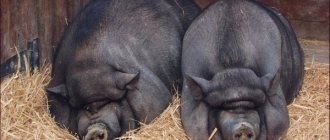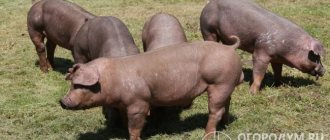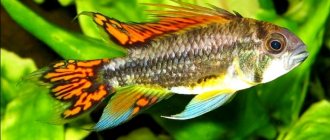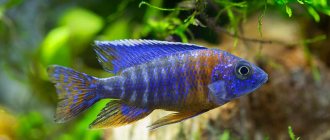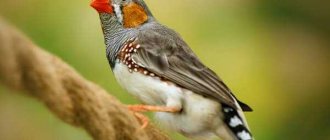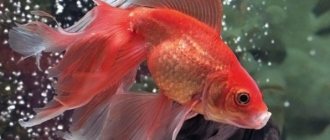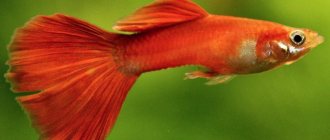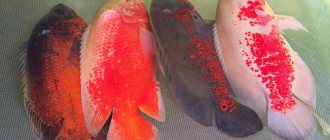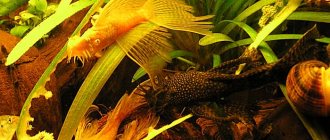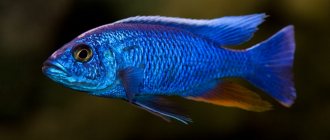Domestic livestock breeders are familiar with Vietnamese pot-bellied pigs relatively recently, but over the past decades, these “Asians” have gained great popularity and are widespread in many regions of Russia and other post-Soviet countries.
Vietnamese breed pigs (pictured) are unpretentious in care and undemanding when it comes to feed
The breed is not officially registered in the State Register of the Russian Federation, but experts consider it very promising and profitable , very suitable for keeping and breeding in personal households and farms. This opinion is based on the existing experience in raising Vietnamese pot-bellied pigs and the combination of their main characteristics:
| Parameter | Characteristic |
| Animal | Pig |
| Breed | Vietnamese (Asian) potbellied |
| Productive type | Bacon |
| Live weight of adults | Pig averages 100-120 kg (up to 140), boar – 120-140 kg (maximum up to 200 kg) |
| Age of puberty in pigs | 4 months |
| Multiple pregnancy | 4-6 piglets in the first farrowing, in subsequent farrows – 8-12 (up to 20) |
| Suit | Black (often with white spots on the head), sometimes white, red, marbled |
| Gaining live weight by the age of 7-8 months (optimal for slaughter) | 75-80 kg |
| Average daily weight gain | 250-500 g |
| Meat quality | High |
| Meat yield from carcass | 70-75% |
| The thickness of the subcutaneous fat layer at a live weight of 100-110 kg (by 10 months of age) | Up to 35 mm (with meat and fat fattening technology) |
| Disease resistance | High immunity |
| Registration in the State Register of the Russian Federation | Breed not included |
To learn more about the breed and the work to improve it, we suggest watching the following video:
Origin story
Photo:
The Vietnamese pot-bellied pig, which is also called the Asian herbivore, first appeared in Southeast Asia.
Only in 85 of the last century it was brought to other continents from Vietnam. That is why it received such a name, although it is more correct to say: Asian pot-bellied pig.
Initially, the breed was recognized only in Canada and the United States of America. Only after a while did farmers from European countries start breeding Vietnamese pigs.
Only after this breed gained recognition in Europe did it come to our country. The Vietnamese pot-bellied pig appeared in Russia relatively recently, but it immediately gained popularity among domestic farmers.
Currently, it is being bred more and more often in our country.
Appearance
The appearance features allow you to buy this particular breed without confusing it with others. First of all, it is worth noting that the name Vietnamese pot-bellied pig breed appeared for a reason. Little piglets that are not yet a month old already have sagging bellies. As for fattened adults, their bellies often reach the ground. The colors vary, usually they are black piglets, but white spots may also appear on their body.
Vietnamese pigs are mostly black in color, but can also be black and white.
The muzzle is not as long as that of ordinary pigs. It seems that they lightly pressed on the snout and left it there. The back is wide and the legs are short, so they are quite large in volume and very low in height. The ears are small. Boars are distinguished by the presence of thick bristles. In a short time, a pot-bellied pig reaches a weight of 70-80 kg, but if you keep the animal longer and specially fatten it, the weight of some individuals reaches 150 kg.
Description of the breed
Characteristic:
- The breed is characterized by a black color, black with small white spots on the head and near the hooves.
- The body is wide, squat, the chest is wide.
- The head is small, with a pronounced pug-like appearance; from the moment of puberty, wild boars begin to grow fangs, which reach 10-15 cm by the age of three.
- The ears are small and erect.
- The back is powerful.
- The bristles can be silver, white and even red. Sometimes several colors are mixed on the bristles at once, and this is the norm.
- One of the features by which this breed can be accurately identified is the elongated stubble along the ridge, which in appearance resembles a kind of mohawk.
- The fur is quite long all over the body, and especially on the head and scruff of the neck. At a moment of particular overexcitation, fear or joy - it doesn’t matter, the long hair stands on end, giving the animal a menacing appearance.
- The piglet is flattened.
- Limbs are widely spaced.
Vietnamese pigs grow very quickly.
The weight of animals as they grow is shown in the table below:
Purchasing young stock
When breeding pigs of this breed, you need to purchase piglets. Today you can make this purchase even online. But experts advise going to a farm where qualified livestock specialists work.
Any farm values its authority, so it will not sell young animals with poor genetics.
When purchasing, you should ask to see all the individuals. It is better to choose the most active piglets with a good appetite, without visible defects.
It wouldn't hurt to look at the parents of the pigs. If there are deviations from the standards in their appearance, it is worth looking for other breeders. A specific feature of representatives of this breed is a straight tail that does not curl into a donut and a short muzzle, reminiscent of a pug's muzzle.
Vietnamese piglets
Before purchasing, it is advisable to show young animals to a veterinarian, although farms carefully monitor the health of pigs. As a rule, individuals are sold already vaccinated against dangerous diseases.
Before you go shopping, the pigsty is properly prepared. Young animals need a warm room without drafts and with a normal level of humidity. A building made of wood or brick is best suited for this breed. When purchasing young animals, take into account the size of the pigsty: per adult individual there should be 2.5-3 square meters. m.
You also need to take into account that the breed needs large quantities of green feed and daily walks. If there is no pasture for walking, you should look for another breed. According to the standards existing today, one adult pig needs at least 1 hundred square meters of land. It is advisable to sow the ground with forbs in the spring, which improves the taste of meat. Primarily alfalfa and clover. Young nettle also has a positive effect on the taste of meat.
Reviews
According to farmers, the advantages of the breed include:
- Low feeding costs.
- Compact dimensions, allowing you to keep several individuals at once in one not too large pen.
- Immunity resistant to diseases and temperature changes.
- Possibility of almost year-round (depending on the place of breeding) free range, since pigs tolerate low temperatures well during winter.
- The animals are very clean, free from the specific smell inherent in almost all pigs of other breeds.
- They have tender meat with little fat and no veins. The low cholesterol content of the product makes it possible to eat it for people with vascular diseases.
- Early sexual maturity makes it possible to get the first offspring from a pig that has reached only 7-9 months. Moreover, animals that live about 30 years are capable of farrowing throughout their lives. In addition, Vietnamese breed pigs are incredibly fertile, producing from 12 to 20 piglets at a time.
- Calm and good-natured. They allow the owner to approach the piglets, do not break enclosures, and they have the ability to train.
Interesting Facts
Among their fellows, Asian pigs differ not only in color. They are distinguished by behavioral characteristics, unique abilities and other features:
- pot-bellies can distinguish poisonous herbs from edible ones. This is a genetic feature of animals due to which they can be free-range;
- Vietnamese pigs easily digest green food due to the special structure of the digestive system;
- These extremely peaceful pigs can be overly aggressive. We are talking about the mating season, when in the fight for a female, boars can mortally wound each other.
Breeders of the breed say about pot-bellied piglets that their maintenance is very profitable, since the funds required to raise 1 white pig are enough to raise 4 Vietnamese ones; Unlike their species counterparts, potbellies are very clean, do not dig holes, do not break pens, behave quietly and friendly, rarely get sick and are unpretentious in food, so even beginners in pig farming can breed them.
Meat productivity
Vietnamese pigs are not champions in weight, which is compensated by their excellent taste and rapid growth:
- the weight of a newborn boar is 500-600 g, a pig is 450-550 g;
- the average weight of an adult wild boar is from 120 to 140 kg, but some specimens can gain up to 200 kg;
- an adult pig weighs from 100 to 120 kg, the maximum recorded weight is 140 kg;
- per day, wild boars add 350-450 g, pigs 350-500 g;
- the optimal slaughter age is 7-8 months, upon reaching a live weight of 75-80 kg;
- slaughter yield from 70% to 75%.
Weight gain
Based on the weight gain of Vietnamese piglets by month, the farmer can predict the volume of upcoming profits and determine the time of slaughter of animals. Data on the weight growth of pot-bellied piglets are presented in the table:
| Vietnamese pot-bellied piglets: weight by month | Weight, kg | Weight gain per month, kg |
| 1 month | 3,5-5 | |
| 2 months | 10-20 | 15 |
| 3 months | 21-30 | 10 |
| 4 months | 31-40 | 10 |
| 5 months | 41-50 | 10 |
| 6 months | 51-60 | 10 |
| 7 months | 61-70 | 10 |
| 8 months | 71-80 | 10 |
| 9 months | 81-85 | 5 |
| 10 months | 86-90 | 5 |
| 11 months | 91-95 | 5 |
| 1 year | 96-100 | 5 |
Weight should increase systematically thanks to a balanced diet. Feeding high-calorie cereals, especially corn, will lead to a significant increase in fat and a deterioration in the quality characteristics of meat, and the introduction of large amounts of whole grains will cause digestive upset.
Breeding
Independent breeding of Vietnamese pigs requires compliance with certain rules. For mating, females over 4 months of age, who have gained weight more than 30 kg, and males from six months are selected.
In this case, the animals should not be closely related. You can place a boar with a pig when she shows signs of heat: persistent restlessness; swelling or discharge in the genital loop area.
Vietnamese pigs, when bred at home, are born pregnant 114–118 days after mating.
A few days before the event, the pig warns about the approaching farrowing by restless behavior, attempts to crush the bedding and build the nest.
If the breeder pays attention to the appearance of the female, he will notice signs of drooping of the abdomen, clearly defined milk lobes and enlarged nipples, and the flow of colostrum.
Caring for the livestock from the first days of life plays a decisive role in the success of breeding Vietnamese piglets. During farrowing and for newly hatched piglets, the temperature in the pen is 30–32 °C.
Childbirth in Asian pigs lasts from 3 to 5 hours. When the entire offspring has been born, it is important to wait for the placenta to emerge. The piglets are cleared of mucus, dried, the umbilical cord is treated and placed next to the sow so that she can feed them with colostrum.
The sooner this happens, the greater the likelihood that the animal will grow strong and strong.
How to care
You can replenish the potbelly population in one of the following ways:
- mating sexually mature individuals from the available artiodactyls;
- acquiring young animals.
If there are adult females and boars in the herd, breeding them to produce offspring will not be difficult. The breed is early maturing. Pigs reach puberty at 4 months, weighing 30-35 kg, and boars at the age of 5-6 months, weighing about 40 kg. In the first farrowing, sows bring up to 6 piglets, and in subsequent farrows - up to 18.
In private farms, 1 boar fertilizes 15-20 pigs. In this case, the manufacturer is considered sexually mature after reaching 12-18 months and weighing 150-200 kg. The offspring of a boar of this age will be larger and more viable than those of a younger male. One pig can breed several boars within 12 hours, then there will be more piglets in the litter.
The waiting period for an offspring from a sow is 114-118 days. Farrowing usually proceeds without problems. The procedure lasts 3-5 hours, and the only thing the owner needs to do is clean the area where the sow is kept and cover the floor with fresh straw. After farrowing, the placenta must be destroyed immediately.
Content
Before you go shopping for piglets, you need to find a suitable place to keep them. If you plan to breed Vietnamese pigs for a long time, it is recommended to carefully arrange the premises for them.
Since representatives of this breed are not very large in size, a full-fledged farm can be built in a small area.
Bricks or cinder blocks are best for building a pigsty, but wood can also be used. The main requirements for a pigsty are dryness and warmth.
The area of the pigsty is calculated in advance, depending on the planned number of animals to be raised. 5 m2 of space can accommodate 2 females or 1 sow with piglets.
For a wild boar, 3m2 will be enough. The premises for keeping pigs must be divided into several pens with an area of about 5 square meters. m. Metal or wooden partitions are installed between the machines.
The height of the partitions should be such that an adult pig cannot jump over them. The passage between the machines should be such a width that it is possible to move freely along it with a wheelbarrow for manure.
Pigs love to dig in the ground with their nickels and quickly deteriorate wooden floors. At the same time, they can tear off entire boards, and when walking, get their feet stuck in them, getting injured.
Therefore, it is recommended to make the floor from concrete. A cemented ball has another advantage - cleaning the machines will be much easier.
Vietnamese pigs are distinguished by their exceptional cleanliness, so it is recommended to build a small wooden platform in each pen on which they will sleep. In addition, wood retains heat better and pigs will not freeze in the cold season.
It is also important to ensure good ventilation. If fresh air is not supplied to the barn, the pigs will have to constantly breathe in the fumes emitted by manure and urine, which will have an adverse effect on their health.
In winter, it is recommended to heat the pigsty, especially if one of the pigs has farrowed. Low temperatures can lead to the death of newborn piglets and the sow herself, whose body is weakened after childbirth.
You can heat the room using a conventional stove, potbelly stove, or by installing special heating devices.
In order for piglets to grow faster, they need to be walked during the warm months of the year. Fresh air, physical activity and sunshine help pigs grow and stay healthy.
For each pig it is necessary to allocate 10x10 meters of free space in the open air. The walking area must be fenced with strong boards nailed to powerful logs.
It is also recommended to install a canopy under which the pigs can shelter during rain or extreme heat. Pig skin is quite durable, but it does not protect against annoying insects.
To help animals get rid of flying bloodsuckers, you need to fill part of the walking area with water - the pigs will dig up the ground themselves and will escape from parasites by lying in mud baths. In addition, such baths will help animals cool down in extreme heat.
Competent walking
Vietnamese pigs need fresh air. Daily walking in the warm season will provide animals with good immunity.
It has been noticed that pigs that walk regularly practically do not get sick and gain weight better. Captivity for this breed is destructive - the animals become weak and sick.
If there are no trees at the walking site, then it is better to dig a couple of logs in the area. Pigs love to rub their sides against them. It would be a good idea to organize a canopy so that animals can hide under it from bad weather and scorching sun rays.
Pigs love to bathe in mud to get rid of insects and cool down in the hot summer. Therefore, it is best to organize a pool for them - a small hole in the ground filled with water.
It is necessary to regularly add fresh water to the pool.
Feeding
Standard requirements for pigs in essential nutrients
Vietnamese pigs belong to the bacon breed, so their diet should be dominated by feed that helps accumulate fat. These pigs are distinguished by a unique digestive system (small stomach and short intestines), which ensures the rapid passage of food through the esophagus.
Hard feed containing dense fiber is poorly absorbed by the body of Vietnamese pigs. Legumes and greens are considered the best feed option for these animals.
It is better not to give food in liquid form to pigs, since they will immediately swallow such food without chewing it in their mouth. Thick porridge, as well as fruits and vegetables, work well.
It is allowed to feed pigs with food waste - potato peelings, apple cores, banana peels and other food scraps from the table. The more varied the diet, the better.
Little piglets should be fed mother's milk for up to 1-1.5 months, but it is advisable to introduce complementary foods from the second week after birth. At one month of age, you can take them away from their mother and place them in a separate pen.
The diet of piglets up to 1 month should contain porridge with milk (barley, wheat, corn or oatmeal); from the age of one month, fresh hay can be given. For small pigs, herbs such as nettle, clover, sainfoin, quinoa, and acorn are best suited.
Adult pigs need to be fed according to the season. In the summer, it is enough to feed twice a day, and it is recommended to feed more greens and vegetables.
In the winter months, tops and hay are suitable, and feed should be given 3 times a day. If mixed feed is used, it must be mixed with bran - in this form it will be absorbed much better.
Vietnamese pigs should not be fed any grain. For example, it is better not to feed them corn and oats, since these products will provoke the accumulation of fat and will be bad for the health of the pigs.
In addition, excess fat deposits will negatively affect the quality of meat. Recommended grains for adults are barley, rye and wheat.
Pregnant sows can be fed the same food as regular pigs, but it is recommended to enrich the feed with vitamins - for example, add 1 raw egg, 2 tablespoons of fish oil or whey per 10 kg of feed.
If you plan to slaughter a pig, you should switch to a special diet a month before slaughter. The following daily diet promotes maximum weight gain: (50%), oats (10%), wheat (20%), corn (10%) and peas (10%).
Nutrition
The diet of such animals has some differences from the menu of their usual white relatives, so it is necessary to feed Vietnamese pigs somewhat differently. There are also obvious physiological features that change the feeding plan.
These animals boast a portly belly, but their stomach is very small, and they digest food at an accelerated pace. This is why the order of eating also changes. Twice feedings a day, as is the case with white pigs, are not enough for such creatures, therefore, their number per day must be increased.
Vietnamese pigs love watermelons
These animals are exclusively herbivores, and therefore herbs are very welcome in their menu, but only fresh ones, and it is also allowed to include hay, but not straw, especially stale ones. To this list you should add zucchini, pumpkin, apples, corn, and maybe pears, which is very useful for such pigs.
But it is necessary to give up beets, they are harmful to them. And another important point: it is not recommended to feed such animals exclusively with pasture; it is necessary to add compound feed.
Of course, any owner wants the meat of Vietnamese pigs to be of excellent quality, especially if they were bred to produce bacon. It is important here that this product does not turn out to be too fatty, and therefore you should not overfeed the animals, but it is recommended to constantly monitor their body weight.
In this case, the ideal weight is about 100 kg, maybe a little more or less, ten kilograms. At the same time, if the main goal is to obtain bacon, it is also considered unnecessary to feed barley and corn in volumes exceeding 10% of the total feed mass.
Diseases and their treatment
Pigs have innate immunity and are perfectly acclimatized to harsh climatic conditions. If you follow the basic rules of keeping and a balanced diet, they are practically not susceptible to diseases.
Trouble is caused by helminths, to get rid of which animals are given a subcutaneous injection of Ecomectin (Ivermiktin) every 4 months, or the drug Albendazole (Fonbendazole) is added to the food.
When quickly switching to new foods, intestinal upset appears, which can be eliminated at home with Smecta or Biovittom.
Diseases
Violation of the rules of care is fraught with the development of diseases. The most common ones are:
- Infection with worms. This happens when the premises are poorly sanitized. Bowls with food must be periodically washed with a solution of potassium permanganate, and the emptyings must be thoroughly rinsed off. The problem is eliminated with tablets.
- Dysentery. The reason for the development is unsanitary conditions. Adults rarely suffer from it, but young animals are under threat. The treatment is carried out by a veterinarian.
- Salmonellosis is a disease that can be prevented by timely vaccination.
- Erysipelas. Piglets can die from this infection. At first, the animal completely refuses food, then breathing becomes difficult and the temperature rises. Individuals aged 3 months and older are most at risk of the disease. up to 1 year.
- Auseki. This is a viral disease, from which only timely vaccination can save. Symptoms: walking in circles, followed by itching, paralysis, and convulsions.
Timely prevention and careful attention will prevent and cure diseases and save the life of animals.
Mating and farrowing
Gestation lasts about 120 days. A week before giving birth, the pig becomes restless, begins to build a nest, her nipples swell, and her stomach drops.
Before farrowing, the pig will not eat anything, and a clear liquid will be released from the mammary glands - colostrum. If such phenomena are observed, you need to carefully prepare - clean the machine, put fresh straw, refresh the water in the drinking bowl.
There is no need to interfere with the birth process - the sow herself knows what and how to do. In some cases, when a pig is giving birth for the first time, you can help it a little by wiping the newborn piglets with a clean cloth and cutting the umbilical cord.
The duration of farrowing is usually about 4 hours and it ends with the release of the placenta, which must be removed from the pen.
At the age of 40 days, Vietnamese piglets are pierced with deworming drugs (for example, brovandazole). Additional vaccinations against various diseases may be necessary, but this issue is already being resolved with the veterinarian.
Meat quality
Asian pigs are the owners of marbled meat, in which layers of muscle tissue are interspersed with thin layers of fat. According to reviews, the meat of pot-bellied pigs has a pleasant, rich taste. In young piglets it is light pink, in older animals it is intense pink.
In piglets, the meat has a dense structure, and when it reaches 6-7 months, when the pig begins to become overgrown with lard, the meat becomes marbling.
In uncastrated wild boars and whips, the muscle tissue has an unpleasant odor due to the increased testosterone content. This is especially evident during heat treatment.
Vietnamese meat is in great demand because it contains 10 times less cholesterol than other breeds of pigs.
